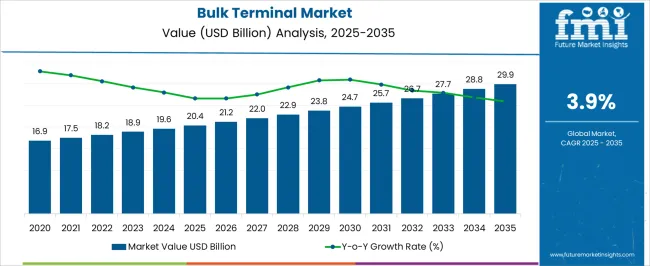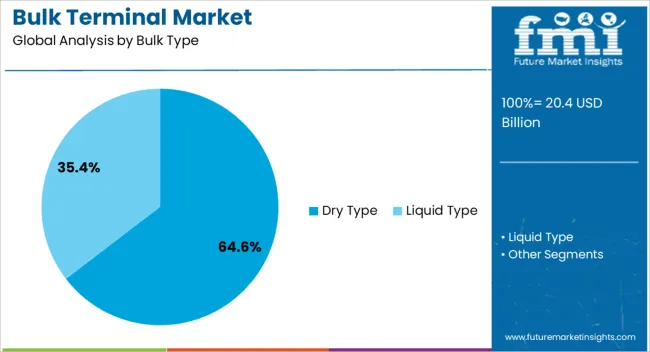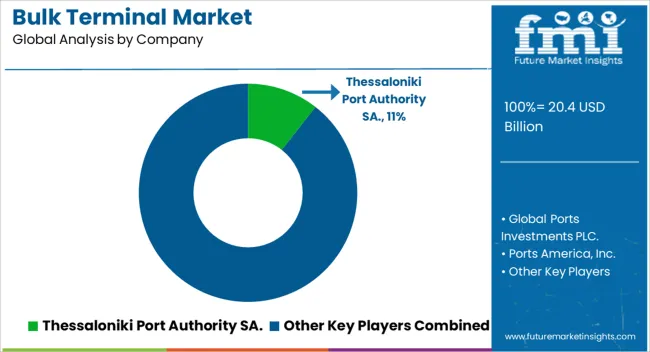The Bulk Terminal Market is estimated to be valued at USD 20.4 billion in 2025 and is projected to reach USD 29.9 billion by 2035, registering a compound annual growth rate (CAGR) of 3.9% over the forecast period.
The bulk terminal market is experiencing stable growth, shaped by global trade dynamics, infrastructure expansion, and the growing movement of raw materials and commodities across ports. Developments in global shipping logistics, particularly the rising volume of seaborne trade and containerization of bulk cargo, have influenced investment in port modernization and terminal automation.
Industry announcements and port authority disclosures have emphasized the need for efficient cargo handling systems, prompting upgrades in terminal equipment and digital operations. Increasing demand for energy, construction materials, and agricultural exports has led to heightened activity in bulk terminals, with emerging economies rapidly expanding their port handling capacities.
Additionally, government-led trade corridor initiatives and public-private partnerships in port development have catalyzed terminal construction and throughput capacity enhancements. Moving forward, the market is expected to grow further as dry and liquid bulk volumes continue to scale, supported by technological integration such as automated cranes, real-time cargo tracking, and digital scheduling systems. Segmental dominance is anticipated from Dry Type bulk terminals, reflecting their critical role in handling key industrial materials such as coal, ores, grains, and cement.

| Metric | Value |
|---|---|
| Bulk Terminal Market Estimated Value in (2025 E) | USD 20.4 billion |
| Bulk Terminal Market Forecast Value in (2035 F) | USD 29.9 billion |
| Forecast CAGR (2025 to 2035) | 3.9% |
The market is segmented by Bulk Type and region. By Bulk Type, the market is divided into Dry Type and Liquid Type. Regionally, the market is classified into North America, Latin America, Western Europe, Eastern Europe, Balkan & Baltic Countries, Russia & Belarus, Central Asia, East Asia, South Asia & Pacific, and the Middle East & Africa.

The Dry Type segment is projected to account for 64.6% of the bulk terminal market revenue in 2025, establishing it as the leading bulk type category. This dominance has been driven by the high volume movement of dry commodities such as iron ore, coal, grains, and fertilizers, which are fundamental to construction, power generation, and food production sectors.
Global trade data and logistics reports have highlighted that dry bulk cargo constitutes the largest share of maritime transport tonnage, reinforcing the importance of specialized dry terminals. The segment has also benefited from infrastructure investments in mechanized unloading systems, dust control technologies, and advanced stockyard management systems, which have improved throughput efficiency and environmental compliance.
Port authorities in Asia-Pacific, Latin America, and Africa have scaled up dry bulk terminal capacity to accommodate rising demand from mining and agricultural exports. As global commodity flows continue to rise and supply chain resilience remains a strategic focus, the Dry Type segment is expected to maintain its leadership in the bulk terminal market.
Increasing Trade of Natural Gas Worldwide
High emissions from power and automobile industries have led to the adoption of natural gas as an alternative fuel. Key consumer countries like Japan, the United States, and Europe are adopting natural gas due to low emissions and the abundant nature of natural gas. This factor is estimated to spur demand for cargo terminals.
Rising Focus on Sustainability to Surge Sales
The focus on sustainability is increasing, involving eco-friendly practices, renewable energy solutions, and emission reduction strategies to minimize environmental impact. This shift toward clean energy sources is fueling changes in bulk commodity handling and infrastructure in terminals.
High Initial Investment and Operational Cost to Impede Growth
Seaports are significant for global trade, handling heavy cargo and bulk materials. However, setting up a bulk terminal requires a rigid surface, reliable construction, and adequate berthing for ships and stevedoring facilities.
Dry bulk construction is time-consuming and requires significant investments, hindering growth. Land reclamation involves depositing millions of tons of rocks, cement, and materials to create elevated surfaces in shallow water conditions, ensuring proper land connectivity for inland transportation. The average cost of construction is set to pose business risks, potentially hampering growth.
Inadequate Infrastructure to Hamper Growth
Infrastructure constraints in terminal services are set to hinder growth due to outdated port infrastructure, inadequate capacity, and connectivity, affecting logistics efficiency and supply chains.
Bulk storage facilities often need more storage, causing congestion and restricted product variety, reducing industry flexibility and competitiveness. Inadequate connectivity poses a challenge for terminal service development, leading to high costs and limited access for potential customers.
The cargo terminal sector grew at a CAGR of 3% from 2020 and 2025. The market reached USD 18,940 million in 2025. Bulk terminals have evolved over time due to changes in demand and production patterns worldwide across several industries. In the historical period, the oil and gas sector led to increased investments in these terminals for petroleum products.
Technological developments improved efficiency, reduced labor costs, and surged safety in the sector. Environmental regulations further influenced the development of bulk terminals, requiring investments in pollution control technologies.
Bulk commodity dynamics, supply-demand dynamics, and geopolitical factors also influenced the investment decisions of several leading companies. Governments and private sector entities invested in port and terminal infrastructure to meet the growing demand and enhance global trade competitiveness.
Over the forecast period, the sector is poised to exhibit healthy growth, reaching USD 28,800 million by 2035. The outlook for the market appears promising, spurred by rising global trading activities, infrastructure projects, and surging export demand for effective solutions.
New investments in transportation and digitization are poised to enhance operational efficiency and competitiveness in the sector. The industry is set to witness steady growth as these terminals play a key role in facilitating logistics and supporting the global supply chain.
The following table shows the estimated growth rates of the leading markets. The United States is anticipated to remain at the forefront in North America, with a CAGR of 2.6% through 2035. In South Asia and Pacific, India is projected to witness a CAGR of 4.5% by 2035, followed by China at 3.6%.
| Countries | CAGR 2025 to 2035 |
|---|---|
| Kingdom of Saudi Arabia | 6.4% |
| China | 3.6% |
| United States | 2.6% |
| ASEAN | 5.3% |
| India | 4.5% |
Over the assessment period, demand in the United States is set to rise at 2.6% CAGR. There are numerous bulk terminals strategically located across the country. These handle various commodities like petroleum, chemicals, agricultural products, minerals, ores, coal, and industrial materials. Key ports along the East Coast, Gulf Coast, West Coast, and Great Lakes regions facilitate domestic and international trade through extensive coastline and transportation networks.
The Kingdom of Saudi Arabia is set to experience significant growth in the forecast period. This is due to abundant oil and petrochemical reserves, strategic location on maritime routes, strong infrastructure, and modern port facilities. Growing demand for liquefied natural gas (LNG) presents new opportunities for leading manufacturers in the kingdom.
As the Kingdom of Saudi Arabia continues to invest in LNG infrastructure and processing facilities, the need for specialized storage and export facilities is set to increase. This development is propelled by the kingdom’s strong infrastructure and modern port facilities. By 2035, the Kingdom of Saudi Arabia is projected to rise at a CAGR of 6.4%.
China's transition to clean energy necessitates investments in wind farms and renewable energy components, fueling demand for bulk terminals. The country is anticipated to reach USD 2,658.2 million by 2035. Over the forecast period, demand in China is set to increase at a steady CAGR of 3.6%.
The section below analyzes the leading segment of the market. In terms of bulk type, the dry type segment is estimated to account for a share of 64.6% in 2025. Further, the liquid type segment is anticipated to follow by holding a share of 35.4% in 2025.
| Segment | Dry Type (Bulk Type) |
|---|---|
| Value Share (2025) | 64.6% |
Over the forecast period, demand for dry bulk is forecast to rise at a CAGR of 3.5%. This growth is attributed to rising demand for dry goods, including grains and coal, which are significant raw materials for various industries. As population growth and urbanization increase, these resources are gaining traction in the arid region's resource sector.
Technological innovations and automation have transformed dry terminal operations, resulting in fast loading and unloading, improved safety standards, and reduced costs. The dry bulk sector offers attractive investment opportunities due to the resilience to industry fluctuations and robust long-term demand prospects.
The evolution of technology and automation is reshaping dry bulk terminal operations, leading to high productivity and reduced costs. The segment now has unique equipment for loading and unloading, enhancing the speed and safety of bulk handling. Over the forecast period, demand for dry bulk is forecast to rise at a CAGR of 3.5%. By 2035, the target segment is estimated to reach USD 17,138 million.
| Segment | Liquid Type (Bulk Type) |
|---|---|
| Value Share (2025) | 35.4% |
Bulk terminals manage several types of liquid for storage and transportation, including crude oil, refined petroleum, chemicals, liquefied gas, vegetable oils, liquid fertilizers, and water. These liquids serve numerous industries like oil and gas, chemicals, agriculture, and renewable energy.
Bulk terminals ensure efficient handling, storage, and distribution while adhering to safety and regulatory standards and meeting industrial demands. By 2035, demand for bulk terminals from liquid type segment is anticipated to surge significantly.

Leading service providers collectively hold a substantial share, comprising around 20% to 25% of the sector. Thessaloniki Port Authority SA, Global Ports Investments PLC, Ports America, Inc., China Merchants Port Holdings Co. Ltd., APM Terminals, and DP World Ltd. are the key service providers in the industry.
Key companies and manufacturers are investing in continuous research for producing new products and increasing production capacity to meet end-user demand. These companies are also showing an inclination toward adopting strategies, including acquisitions, partnerships, mergers, and facility growth, to strengthen footprint.
The sector is characterized by numerous large and medium-sized players, primarily investing and forming strategic agreements to capture a significant value.
Industry Updates
As per bulk type, the industry has been categorized into dry type and liquid type. The dry type segment is further divided into grain, coal, iron ore, and others. Also, the liquid type segment is bifurcated into oil and gas.
Industry analysis has been carried out in key countries of North America, Latin America, Western Europe, Eastern Europe, South Asia and Pacific, East Asia, and the Middle East and Africa.
The global bulk terminal market is estimated to be valued at USD 20.4 billion in 2025.
The market size for the bulk terminal market is projected to reach USD 29.9 billion by 2035.
The bulk terminal market is expected to grow at a 3.9% CAGR between 2025 and 2035.
The key product types in bulk terminal market are dry type, _grain, _coal, _iron ore, _others, liquid type, _oil and _gas.
In terms of , segment to command 0.0% share in the bulk terminal market in 2025.






Full Research Suite comprises of:
Market outlook & trends analysis
Interviews & case studies
Strategic recommendations
Vendor profiles & capabilities analysis
5-year forecasts
8 regions and 60+ country-level data splits
Market segment data splits
12 months of continuous data updates
DELIVERED AS:
PDF EXCEL ONLINE
Bulk Bag Market Forecast and Outlook 2025 to 2035
Bulk Molding Compounds Market Size and Share Forecast Outlook 2025 to 2035
Bulk Bag Unloaders Market Size and Share Forecast Outlook 2025 to 2035
Bulk Bag Divider Market Size and Share Forecast Outlook 2025 to 2035
Bulk Container Packaging Market Size, Share & Forecast 2025 to 2035
Bulk Chemical Packaging Market Trends and Growth 2025 to 2035
Bulk Liquid Transport Packaging Market from 2025 to 2035
Bulk Food Ingredients Market Growth – Industry Insights & Trends 2025 to 2035
Bulk Material Handling System Market Growth - Trends & Forecast 2025 to 2035
Market Share Breakdown of Bulk Container Packaging Industry
Competitive Overview of Bulk Bag Divider Companies
Industry Share Analysis for Bulk Bag Conditioner Companies
Bulk Bag Dischargers Market Trends – Growth & Outlook 2024-2034
Global Bulk-Drug Compounding Market Analysis – Size, Share & Forecast 2024-2034
Bulk Insulated Containers Market
Bulk Liquid Containers Market
Bulk Tote Dumpers Market
Food Bulking Agents Market - Size, Share, and Forecast Outlook 2025 to 2035
Inner Bulk Liners Market Size and Share Forecast Outlook 2025 to 2035
Type-C Bulk Bags Market Size and Share Forecast Outlook 2025 to 2035

Thank you!
You will receive an email from our Business Development Manager. Please be sure to check your SPAM/JUNK folder too.
Chat With
MaRIA